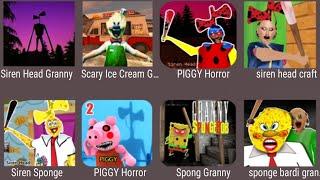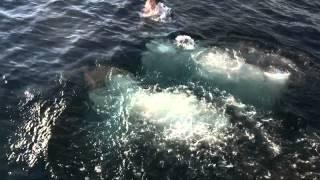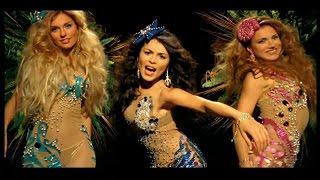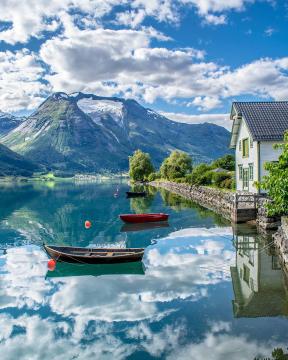Freshwater Sponge facts: they were once considered plants | Animal Fact Files
Описание
There are approximately 200 living species of these delicate sponges. They appear in clean water systems like lakes and slow moving streams. Freshwater sponges have a green appearance due to algae that live on them but they can also appear brown, beige, and white. Freshwater sponges are porous and might seem slimy like algae since they come in a similar color, but they're quite coarse. Freshwater sponges look like plants but they eat other organisms to survive and can't produce their own energy - so they're animals!
Scientific Name: Family - Spongillidae
Range: clean, clear water systems throughout the world
Size: 1-4cm thick (up to 1.5inches); more than 3 feet (91cm) across (or much, much smaller)
Diet: planktonic organisms and nutrients from symbiotic algae
Lifespan: potentially indefinite through asexual reproduction
You can learn more on:
Twitter - https://twitter.com/animalfactfiles
Facebook - https://facebook.com/animalfactfiles
---
We always do what we can to be as accurate as possible, but we're only human; if you catch a mistake please let us know and provide a link for verification!
---
All images, videos and sound effects used herein are 1) public domain, 2) used under a Creative Commons license, 3) used with the express permission of the copyright holder, or 4) used under the parameters of Fair Use law.
Credits via Youtube:
Krzysztof Lewinski - https://www.youtube.com/watch?v=gNgbx1a1Xkg
MicrophonicFool - https://www.youtube.com/watch?v=akeUz5ryPos
Credits via Flickr:
Dr Mary Gillham - https://www.flickr.com/photos/marygillhamarchiveproject/37737816912
Heikki Rauhala - https://www.flickr.com/photos/hvrauhal/7670515968; https://www.flickr.com/photos/hvrauhal/7670494456
Credits via Wiki Users:
Kirt L. Onthank - https://commons.wikimedia.org/wiki/File:Spongilla_lacustris.jpg
Lamiot - https://commons.wikimedia.org/wiki/File:Gemmules_Spongilla_lacustris_438.JPG; https://commons.wikimedia.org/wiki/File:Gemmules_Spongilla_lacustris_2014-10-31_a568.JPG; https://commons.wikimedia.org/wiki/File:Gemmules_Spongilla_lacustris_DSCN4463.JPG; https://commons.wikimedia.org/wiki/File:Gemmules_Spongilla_lacustris_2014-11-16_a_3722.JPG; https://commons.wikimedia.org/wiki/File:Gemmules_Spongilla_lacustris_2014-11-16_a_3723.JPG; https://commons.wikimedia.org/wiki/File:Gemmules_Spongilla_lacustris_DSCN4474.JPG; https://commons.wikimedia.org/wiki/File:Gemmules_Spongilla_lacustris_2014-10-31_a574.JPG; https://commons.wikimedia.org/wiki/File:Gemmules_Spongilla_lacustris_2014-11-16_a_3721.JPG; https://commons.wikimedia.org/wiki/File:Gemmules_Spongilla_lacustris_2014-11-16_a_3724.JPG; https://commons.wikimedia.org/wiki/File:Gemmules_Spongilla_lacustris_2014-11-16_a_3727.JPG; https://commons.wikimedia.org/wiki/File:Gemules_grande_Spongilla_lacustris_2014-11-10.jpg; https://commons.wikimedia.org/wiki/File:Pseudof%C3%A8ces_moules_z%C3%A9br%C3%A9es_sur_spongilla_lacustris_2014_10_02.jpg; https://commons.wikimedia.org/wiki/File:%C3%89ponge_d%27eau_douce_Spongilla_lacustris_Authie_Lamiot_2017a_10.jpg; https://commons.wikimedia.org/wiki/File:%C3%89ponge_d%27eau_douce_de_forme_complexe_Spongilla_lacustris_F_Lamiot_2017_05.jpg; https://commons.wikimedia.org/wiki/File:%C3%89ponge_d%27eau_douce_de_forme_complexe_Spongilla_lacustris_F_Lamiot_2017_06.jpg; https://commons.wikimedia.org/wiki/File:%C3%89ponge_d%27eau_douce_de_forme_complexe_Spongilla_lacustris_F_Lamiot_2017_03.jpg; https://commons.wikimedia.org/wiki/File:%C3%89ponge_d%27eau_douce_Authie_Lamiot_2017a_04.jpg; https://commons.wikimedia.org/wiki/File:Spongilla_lacustris_%C3%A9ponge_d%27eau_douce_Authie_Lamiot_2017a_09.jpg
Other attributions:
seawildearth - https://vimeo.com/56526602
ROV Innovations - https://vimeo.com/103309904
Websites used for research collection:
https://www.britannica.com/animal/freshwater-sponge
https://www.itis.gov/servlet/SingleRpt/SingleRpt?search_topic=TSN&search_value=47691#null
https://www.nps.gov/articles/freshwater-sponges.htm
https://fortress.wa.gov/ecy/gisresources/lakes/AquaticPlantGuide/descriptions/bryozoan.html
https://phys.org/news/2019-03-clues-freshwater-sponges.html
http://fieldguide.mt.gov/speciesDetail.aspx?elcode=IZSPN14010
https://www.indefenseofplants.com/blog/2016/8/9/freshwater-sponges
http://fwp.mt.gov/mtoutdoors/HTML/articles/portraits/2012/sponges.htm
https://onlinelibrary.wiley.com/doi/abs/10.1111/ivb.12258
https://www.google.com/books/edition/Ecology_and_Classification_of_North_Amer/iOI9ifbikoQC
https://www.google.com/books/edition/Tracking_Environmental_Change_Using_Lake/hurdBgAAQBAJ
https://www.google.com/books/edition/Identification_Guide_of_Freshwater_Macro/-mm5rt6IRxwC
https://www.google.com/books/edition/Pennak_s_Freshwater_Invertebrates_of_the/GqIctb8IqPoC
This video is licensed under a CC BY-SA 3.0 license (https://creativecommons.org/licenses/by-sa/3.0/)*.
*you can find information about all the different types of CC licenses here: https://creativecommons.org/
**changes were made to the original


![Plants vs. Zombies 2 [миссии от Dr. Edgar Zomboss]](https://f-radio.ru/uploads/thumbs/713d980cd-1.jpg)


















